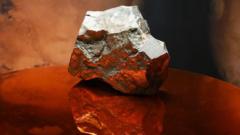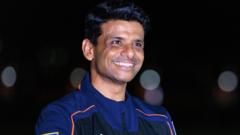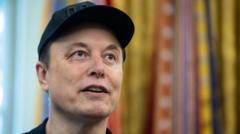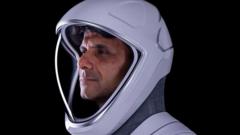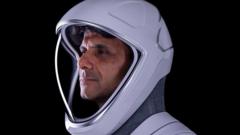With advancements in AI and aerospace technology leading to successful robotic missions, the debate heats up over the future involvement of human astronauts in space, balancing cost, risk, and the essential role of inspiration in exploration.
The Future of Space Exploration: Will Robotic Missions Replace Human Astronauts?

The Future of Space Exploration: Will Robotic Missions Replace Human Astronauts?
As AI technology evolves, experts debate the necessity and advantages of robotic missions over human astronauts in space exploration.
In a remarkable achievement in space exploration, an autonomous spacecraft has flown past the Sun closer than any human-made object in history. NASA's Parker Solar Probe completed this groundbreaking mission with its pre-programmed systems, conducting operations without any direct human interaction or communication with Earth. This autonomous flight demonstrates the increasing capabilities of robotic technology, raising important questions about the future role of humans in space.
For the past sixty years, robotic probes have been at the forefront of space exploration, exploring areas that are inaccessible to humans. The Parker Solar Probe, during its 10-day mission, faced extreme temperatures exceeding 1000°C, highlighting the extreme environment that robots are capable of handling. This success signals a potential shift in how space missions might be conducted in the future.
Prominent figures in astronomy, like Lord Martin Rees, the UK’s Astronomer Royal, argue that with the rapid advances in robotics and artificial intelligence, the case for sending humans into space is weakening significantly. He suggests that the risk to human astronauts and the financial burden of sending them are increasingly challenging to justify. Rees argues that human missions should be reserved for private ventures, rather than funded by taxpayers.
Physicist Andrew Coates supports this notion, stating that robots in space are more economical and can perform complex tasks over longer distances. He believes that with the continual advancement of AI, robotic missions will become even more efficient. Yet, this begs the question: are there tasks unique to human beings that robots cannot replicate, despite rapid technological growth?
Humans have so far only traveled to Earth's orbit and the Moon, whereas robotic spacecraft have visited all geographic features of the solar system, illustrating the limitations of human potential in space. The approximately 700 people who have ventured into space have primarily engaged with low Earth orbit or suborbital missions, with prestige playing a substantial part in supporting human presence in space. Dr. Kelly Weinersmith, a biologist, notes that human presence in space often serves as a display of political and scientific prowess.
While human astronauts exhibit a unique versatility and speed in executing tasks, they also require life-support systems, making them much more challenging and expensive to sustain in the harsh environment of space. This is where robotic counterparts shine, such as planetary rovers like Curiosity, which autonomously make critical decisions to conduct scientific research without Earth-based support.
Advancements in AI, robotics, and humanoid technology signify that human and robotic missions may complement rather than compete with one another. AI applications could automate mundane tasks for astronauts, allowing them to concentrate on crucial research elements. However, the current technology has limitations, as systems that require extensive processing power cannot yet be effectively deployed on Mars rovers.
NASA’s Valkyrie robot poses an exciting possibility for undertaking complex tasks once reserved for astronauts. Deployed inside habitats where humans may not be able to work, these humanoid machines could manage maintenance and repairs, enhancing efficiency in space exploration.
Despite the impressive strides made by robotic technologies, they are steeped in limitations. Robots often move much slower than humans, and their lack of emotional or inspirational presence cannot be overstated. The excitement and motivation humans provide when they step into space extend beyond mere scientific inquiry; they spark public interest—a critical factor often overlooked.
With no human having traveled beyond low Earth orbit since 1972, NASA's Artemis program aims to reestablish a human foothold on the Moon, planning crewed missions by the decade's end. Meanwhile, private companies, like SpaceX, envision greater ambitions, aiming for human colonies on Mars.
While the unknowns of living on Mars persist, discussions around the ethics and feasibility of such endeavors continue to evolve. The vision of a future where humans are part-machine, adapting to the extreme space environment, surfaces as a possibility for the exploration of new frontiers.
In summary, as robotic missions increasingly demonstrate their remarkable capabilities, the conversation around their potential to replace human astronomers in space becomes ever more complex. Until a definitive resolution emerges, humanity's journey through the cosmos will likely continue to be a blend of robotic exploration and human adventure—a partnership that inspires hope and ignites curiosity among future generations.
For the past sixty years, robotic probes have been at the forefront of space exploration, exploring areas that are inaccessible to humans. The Parker Solar Probe, during its 10-day mission, faced extreme temperatures exceeding 1000°C, highlighting the extreme environment that robots are capable of handling. This success signals a potential shift in how space missions might be conducted in the future.
Prominent figures in astronomy, like Lord Martin Rees, the UK’s Astronomer Royal, argue that with the rapid advances in robotics and artificial intelligence, the case for sending humans into space is weakening significantly. He suggests that the risk to human astronauts and the financial burden of sending them are increasingly challenging to justify. Rees argues that human missions should be reserved for private ventures, rather than funded by taxpayers.
Physicist Andrew Coates supports this notion, stating that robots in space are more economical and can perform complex tasks over longer distances. He believes that with the continual advancement of AI, robotic missions will become even more efficient. Yet, this begs the question: are there tasks unique to human beings that robots cannot replicate, despite rapid technological growth?
Humans have so far only traveled to Earth's orbit and the Moon, whereas robotic spacecraft have visited all geographic features of the solar system, illustrating the limitations of human potential in space. The approximately 700 people who have ventured into space have primarily engaged with low Earth orbit or suborbital missions, with prestige playing a substantial part in supporting human presence in space. Dr. Kelly Weinersmith, a biologist, notes that human presence in space often serves as a display of political and scientific prowess.
While human astronauts exhibit a unique versatility and speed in executing tasks, they also require life-support systems, making them much more challenging and expensive to sustain in the harsh environment of space. This is where robotic counterparts shine, such as planetary rovers like Curiosity, which autonomously make critical decisions to conduct scientific research without Earth-based support.
Advancements in AI, robotics, and humanoid technology signify that human and robotic missions may complement rather than compete with one another. AI applications could automate mundane tasks for astronauts, allowing them to concentrate on crucial research elements. However, the current technology has limitations, as systems that require extensive processing power cannot yet be effectively deployed on Mars rovers.
NASA’s Valkyrie robot poses an exciting possibility for undertaking complex tasks once reserved for astronauts. Deployed inside habitats where humans may not be able to work, these humanoid machines could manage maintenance and repairs, enhancing efficiency in space exploration.
Despite the impressive strides made by robotic technologies, they are steeped in limitations. Robots often move much slower than humans, and their lack of emotional or inspirational presence cannot be overstated. The excitement and motivation humans provide when they step into space extend beyond mere scientific inquiry; they spark public interest—a critical factor often overlooked.
With no human having traveled beyond low Earth orbit since 1972, NASA's Artemis program aims to reestablish a human foothold on the Moon, planning crewed missions by the decade's end. Meanwhile, private companies, like SpaceX, envision greater ambitions, aiming for human colonies on Mars.
While the unknowns of living on Mars persist, discussions around the ethics and feasibility of such endeavors continue to evolve. The vision of a future where humans are part-machine, adapting to the extreme space environment, surfaces as a possibility for the exploration of new frontiers.
In summary, as robotic missions increasingly demonstrate their remarkable capabilities, the conversation around their potential to replace human astronomers in space becomes ever more complex. Until a definitive resolution emerges, humanity's journey through the cosmos will likely continue to be a blend of robotic exploration and human adventure—a partnership that inspires hope and ignites curiosity among future generations.


